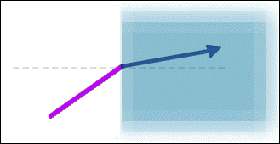 Refraction makes a pencil look bent where it enters water
Refraction makes a pencil look bent where it enters water| home | stands | games | about | school | links |
Scientists at the University of California have created a material which could be used to make a perfect lens, because a key property of the material - its refractive index - is negative.
When light passes from one medium to another (for example, when a beam of light passes through air and into water, or vice versa), the change of speed causes it to change direction. This accounts for the well-known fact that a stick half under water looks bent: light from the submerged part of the stick changes direction as it reaches the surface, creating the illusion of the bent stick.
 Refraction makes a pencil look bent where it enters water
Refraction makes a pencil look bent where it enters waterThis effect is known as refraction, controlled by a property of the materials known as their refractive index. According to Snell's Law, the degree of refraction depends on the ratio of the two materials' different refractive indices.
Most materials have a refractive index greater than 1, which means that as light enters the material from air, the angle of the ray in the material will be more nearly "normal" (perpendicular) to the surface than it was before it entered.
 As light enters a conventional material such as water or glass, it
is bent or "refracted". The degree of refraction depends on the
material's refractive index.
As light enters a conventional material such as water or glass, it
is bent or "refracted". The degree of refraction depends on the
material's refractive index.
But what would it mean to have a material of negative refractive index? This
would be a very odd kind of material indeed, where the light was bent so much
as it entered that it ended up on the same side of the normal as it started.
Such a material would have very counterintuitive optical properties. However,
it could also be very useful. For example, it could be used to make a perfect
lens, which focused all the information about a source object at a point. In
contrast, lenses made from conventional materials, such as glass, with positive
refractive index, necessarily lose some information. 
The theoretical possibility of a material with negative refractive index was known about, but until recently it was assumed that no such material existed. Now, however, scientists at the University of California have discovered a material with just this property.
The possibility of negative refractive index was
first raised by the Russian physisicst, Victor Veselago, in the 1960s. He
realised that if two quantities, the electric permittivity and the magnetic
permeability, of the material, were both negative, Maxwell's equations of
electromagnetism would give a negative refractive index. The California team
laid down copper resonators with negative permeability, and copper wire strips
with negative permittivity, on opposite sides of the same piece of printed
circuit board. The result had negative refractive index.
<go to top>
Refractive index is linked to the speed of light in the material, so it may seem that, for a material to have negative refractive index, light would have to travel backwards in the material - it doesn't, of course! The confusion is due to the subtle but important distinction between
the "phase velocity" of light and its "group velocity". The individual wavefronts that make up the light beam (the "phase") travel backwards, but the beam itself (the "group"), which in this case carries the energy, travels forwards.
The technique is not expected to work for light in the visible part of the spectrum, whose wavelength is too short. However, the team have ideas about how other materials might recreate the effect for visible light.